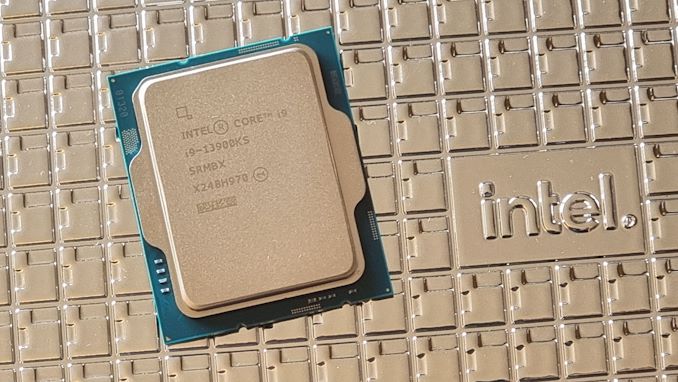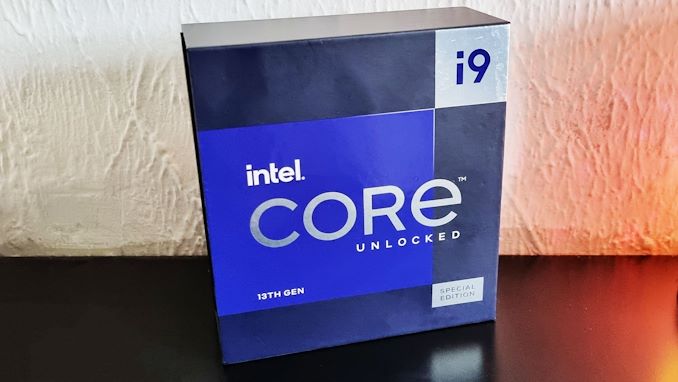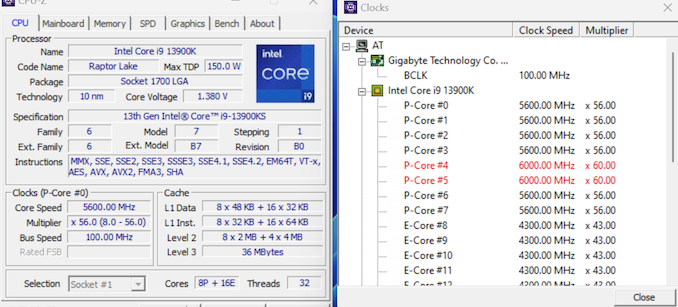The Intel Core i9-13900KS Review: Taking Intel's Raptor Lake to 6 GHz
by Gavin Bonshor on January 27, 2023 10:00 AM EST
Back at Intel's Innovation 2022 event in September, the company let it be known that it had plans to release a '6 GHz' processor based on its Raptor Lake-S series of processors. Though it didn't come with the same degree of fanfare that Intel's more imminently launching 13900K/13700K/13600K received, it put enthusiasts and industry watchers on notice that Intel still had one more, even faster Raptor Lake desktop chip waiting in the wings.
Now a few months later, Raptor Lake's shining moment has arrived. Intel has launched the Intel Core i9-13900KS, a 24-core (8x Perf + 16x Efficiency) part with turbo clock speeds of up to 6 GHz. A mark, which until very recently, was unprecedented without the use of exotic cooling methods such as liquid nitrogen (LN2).
In what is likely to be one of the last in a wide range of Raptor Lake-S SKUs to be announced, Intel has seemingly saved its best for last. The Intel Core i9-13900KS is the faster and unequivocal bigger brother to the Core i9-13900K, with turbo clock speeds of up to 6 GHz while maintaining its halo presence with a 200 MHz increase on both P-core and E-core base frequencies.
Intel's focus and strategy on delivering halo-level processors in limited supply is something that's become a regular part of their product stack over the last few years. We've previously seen the Core i9-9900KS (Coffee Lake) and i9-12900KS (Alder Lake), which were relative successes in showcasing each Core architecture at their finest point. The Core i9-13900KS looks to follow this trend, although it comes as we've reached a time where power efficiency and costs are just a few widely shared concerns globally.
Having the best of the best is somewhat advantageous when there's a need for cutting-edge desktop performance, but at what cost? Faster cores require more energy, and more energy generates more heat; 6 GHz for the average consumer is finally here, but is it worth taking the plunge? We aim to find out in our review of the 6 GHz Core i9-13900KS.
The Intel Core i9-13900KS: Raptor Lake Goes to 6 GHz
AMD and Intel's R&D teams have been working hard in the last few years to keep trading blows in key areas such as core count, IPC performance, and, of course, price. When it comes to focusing on what flagship CPUs are, some gain their status by offering large numbers of cores and very respectable clock speeds to gain that edge in performance over the competition. While getting the right balance of more cores with faster speeds is advantageous, Intel and AMD have in recent years definitely pushed their silicon to very near their ability and capability limits.
The Intel Core i9-13900KS is a juxtaposition in combining high core count with incredibly high frequencies into one silicon package that can be slotted into an appropriate LGA1700 motherboard. It still has the same 24 CPU cores that the Core i9-13900K has. Concerning specifications, all are the same except for clock speeds and TDP. The Core i9-13900KS has eight Raptor Cove Performance (P) cores for the compute workloads potatoes, while sixteen are Efficiency (E) cores based on the Gracemont architecture to pick up other areas of slack.
Intel's hybrid architecture design of performance and efficiency cores, sometimes called big/little, works well. However, it does require a suitable operating system (these days, Windows 11) to utilize the Thread Director scheduling efficiently and effectively.
| Intel 13th Gen Core i9 Series (Raptor Lake-S) | ||||||||||
| AnandTech | Cores P+E/T |
P-Core Base |
P-Core Turbo |
E-Core Base |
E-Core Turbo |
L3 Cache (MB) |
IGP | Base W |
Turbo W |
Price ($) |
| i9-13900KS | 8+16/32 | 3200 | 6000 | 2400 | 4300 | 36 | 770 | 253 | 253/320 | $699 |
| i9-13900K | 8+16/32 | 3000 | 5800 | 2200 | 4300 | 36 | 770 | 125 | 253 | $589 |
| i9-13900KF | 8+16/32 | 3300 | 5800 | 2200 | 4300 | 36 | - | 125 | 253 | $564 |
| i9-13900 | 8+16/32 | 2000 | 5600 | 1500 | 4200 | 36 | 770 | 65 | 219 | $549 |
| i9-13900F | 8+16/32 | 2000 | 5600 | 1500 | 4200 | 36 | - | 65 | 219 | $524 |
| i9-13900T | 8+16/32 | 1100 | 5300 | 800 | 3900 | 36 | 770 | 35 | 106 | $549 |
What makes the Core i9-13900KS different from the rest of the 13th Gen Core i9 series line-up, aside from the apparent increases in P-core and E-core base frequencies and a 6 GHz turbo, is that is a special bin from existing silicon. Experiences with the Core i9-13900K in terms of overclocking ability are mixed, with few of these chips having the capability to run at 6 GHz without exotic cooling methods such as liquid nitrogen and dry ice.
While matching batch numbers is usually the closest method to obtaining parity levels in overclocking ability, it's not an exact science. Talking realistically, no two processors are the same when they come out of the factory. The benefit of having Intel bin their silicon in-house for its KS series is helpful for extreme overclockers, as its guarantees that each i9-13900KS will hit turbo clock speeds of 6 GHz; on two of the P-cores, at least. This also means the Core i9-13900KS, by default, will draw more power and run hotter – upwards of 320 Watts, to be precise.
Looking at the specifications of the Core i9-13900KS, it has 24 cores (8P+16E) and 32 threads, with a maximum P-core turbo of up to 6 GHz. This makes it the fastest desktop processor on the market today, considering out-of-the-box settings and automated technologies implemented. Intel has also increased P-core and E-core base frequencies by 200 MHz from the regular 13900K, making the P-core base on the 13900KS 3.2 GHz and the E-core base 2.4 GHz. All of Intel's 13th Core Series SKUs support either DDR5-5600 or DDR4-3200 memory, which benefits users on a budget. However, buyers of the Core i9 series are likely to opt for DDR5 memory due to extra levels of performance.

The Core i9-13900KS hit 6 GHz on cores P4 and P5 during the XTU stress test (albeit with thermal throttling)
Intel has also increased the base TDP from 125 W to 150 W to account for the additional bump to P and E-core frequencies. What's interesting is that Intel has provided a maximum turbo power specification of 253 W. The other value Intel provides is its new Extreme Power Delivery (EPD) profile of 320 W. This makes it one of the most power-hungry processors out of the box, especially when at full-load in a compute-heavy task.
Outside of the 6 GHz capabilities that the Core i9-13900KS has and the increases mentioned above in base frequencies and power nuances, it shares identical specifications to the Core i9-13900K. This includes the same 36 MB of shared L3 cache across the board, 2 MB of L2 cache per performance (P) core, with 4 MB of L2 cache per each quad efficiency (E) core cluster.

The Intel Core i9-13900KS retail packaging
Things to Know Before Interpreting Our Test Results: Extreme Delivery Profile is 320 W (PL1/PL2)
Expanding into Intel's new Extreme Delivery Profile enables higher power limits on the Core i9-13900KS. As per Turbo Boost Max 3.0, this is set to 253 W, the same PL1/PL2 value as on the Core i9-13900K. For the Core i9-13900KS, the Extreme Delivery Profile enables a higher profile, increasing to 320 W for the PL1 and PL2 values. This allows the Core i9-13900KS more power headroom to enable higher frequencies on two cores, which for Turbo Boost Max 3.0 is 5.8 GHz, and Thermal Velocity Boost is 6.0 GHz.
| Intel Core i9-13900KS P-Core Turbo Frequencies (With Thermal Velocity Boost Active) |
||||||||
| AnandTech | 1 Core | 2 Cores | 3 Cores | 4 Cores | 5 Cores | 6 Cores | 7 Cores | 8 Cores |
| Max Frequency (GHz) | 6.0 | 6.0 | 5.6 | 5.6 | 5.6 | 5.6 | 5.6 | 5.6 |
This completely disregards Intel's base TDP of 150 W, which by default, is also moot on the regular Core i9-13900K as this chip also employs an Extreme Delivery Profile of 253 W for the PL1 and PL2 values. Of course, it has to be stated that motherboard vendors typically ignore PL1 and PL2 values through their implementation of Multi-Core Enhancement (MCE), and they typically go for broke.
Regarding expected performance levels, this is likely to come down to one key area; heat dissipation. The extra heat from the frequency hikes will require more aggressive cooling, and as we saw from our review of the Core i9-12900KS, the KS chips not only run with lots more power compared to the K-series counterparts, but they aren't the easiest to keep cool either.
One thing that is important to consider is that the motherboard has to have a solid power delivery capable of sustaining up to 400 A (ICCMax) to allow the Core i9-13900KS. While the Core i9-13900KS will work in any Z690 and Z790 motherboard, it doesn't mean it should be used just because it works. Look for a motherboard with a decent quality power delivery and good VRM thermal capabilities before considering this chip to operate optimally.
While the premise of the KS series is very favorable for some, it does require more than just installing it into a motherboard and any cooler to get optimal performance. Even with premium AIO coolers, users are likely to expect at least some thermal throttling on the KS chips - 253mm2 is simply not a lot of surface area to be dissipating 320 Watts, even with the help of a heat spreader. The best-case scenario would be a reasonable and well-thought-out custom water cooling loop with premium components and competent cooling fans. This not only adds a very hefty outlay to the cost, but achieving the best performance levels has never been a cheap process to aim for.
The Current CPU Test Suite
For our Intel Core i9-13900KS testing, we are using the following test system:
| Intel 13th Gen Core System (DDR5) | |
| CPU | Core i9-13900K ($589) 24 Cores, 32 Threads 125 W TDP Core i5-13600K ($319) 14 Cores, 20 Threads 125 W TDP |
| Motherboard | GIGABYTE Z690 Aorus Master* |
| Memory | SK Hynix 2x16 GB DDR5-5600B CL46 |
| Cooling | EKWB EK-AIO Elite 360 D-RGB 360mm |
| Storage | SK Hynix Platinum P41 2TB PCIe 4.0 x4 |
| Power Supply | Corsair HX1000 |
| GPUs | AMD Radeon RX 6950 XT, 31.0.12019 |
| Operating Systems | Windows 11 22H2 |
*We changed the motherboard to the GIGABYTE Z690 Aorus Master as the MSI MPG Z790 Carbon WIFI we used for our previous 13th Gen Core series reviews refused to play ball. We don't like to make these changes lightly, but we weren't able to source another Carbon in time for this review
It should be noted that there are no CPU performance differences between Z690 and Z790 motherboards; just that the newer Z790 models benefit from more I/O options. This was confirmed to us by Intel before the release of the 13th Gen Core series.
Our updated CPU suite for 2023 includes various benchmarks, tests, and workloads designed to show variance in performance between different processors and architectures. These include UL's latest Procyon suite with both office and photo editing workloads simulated to measure performance in these tasks, CineBench R23, Dwarf Fortress, Blender 3.3, and C-Ray 1.1.
Meanwhile, we've also carried over some older (but still relevant/enlightening) benchmarks from our CPU 2021 suite. This includes benchmarks such as Dwarf Fortress, Factorio, and Dr. Ian Cutress's 3DPMv2 benchmark.
We have also updated our pool of games going forward into 2023 and beyond, including the latest F1 2022 racing game, the CPU-intensive RTS Total War: Warhammer 3, and the popular Hitman 3.
Due to various issues with Cyberpunk 2077 giving us odd results, we've omitted this from future testing until we can identify the issue and apply a fix.











39 Comments
View All Comments
Slash3 - Saturday, January 28, 2023 - link
They won't, but for a practical reason. It's an always online, frequently updated game, and test data would only be relevant for a single, back to back comparison between parts. No way to accurately compare to previous test results.Peskarik - Saturday, January 28, 2023 - link
Exactly!Please add Microsoft Flight Simulator, Anandtech!!!
dontlistentome - Saturday, January 28, 2023 - link
There was a screenshot floating around not too long ago (from Anandtech iirc) showing why not - the activation process is a nightmare if you try to flip it between machines for testing. The want to use it, MS stand in the way.scottrichardson - Friday, January 27, 2023 - link
I know this is primarily a PC/Windows oriented review but I would have loved to have seen the M2 pro/max included in here. I know that it would have been smoked in most of these benchmarks, especially multi-core, but it would still be interesting to see the power usage and relative performance. Whether we want it or not, there’s a 3rd player in the CPU game now!dontlistentome - Saturday, January 28, 2023 - link
There's a 3rd player taking part, but in a different game. If it can't run the same software or platform, it's irrelevant other than for comparing instruction sets.Tunnah - Friday, January 27, 2023 - link
1/3rd more power for single digit performance increase, how very Intel.Peskarik - Saturday, January 28, 2023 - link
AMD Ryzen 9 7900 wins for me.Carmen00 - Saturday, January 28, 2023 - link
10-20Mhz extra on average, for the "Favoured Cores" only, and for an additional $110 and 25W more. I know there are plenty of Greater Fools in the tech space, but surely there is a limit to how much even they will tolerate?albie_ - Saturday, January 28, 2023 - link
"The peak power figures from our power testing show that the Core i9-13900K drew an impressive 359.9 W at full load."I'm dumbfounded by this statement. Is this supposed to be selling point and good to have? What sort of tech journalist are you?
Ryan Smith - Saturday, January 28, 2023 - link
"What sort of tech journalist are you?"The sarcastic kind.
That statement was fully tongue in cheek. Intel made a consumer desktop chip that draws 360 Watts. It's all a bit silly, innit?